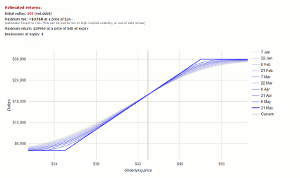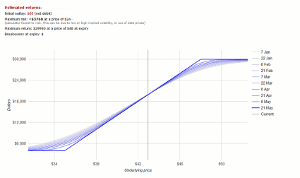While equity collars don't have a universal appeal all the time, James Brumley, of BigTrends.com, details how—in some specific cases—they can serve an important purpose for options traders and—citing an example for support—outlines how they are simple to utilize.
Equity Collars
An equity collar is the simultaneous use of two simple and commonly used equity option trades as means of defending against a loss on an existing stock position. It's called a collar because, though an equity collar trade using options can limit the potential downside of a stock holding, it also limits the potential upside of an existing stock position until the options expire. Thus, the upside and downside are capped or collared.
In many senses equity collars are a type of spread. That is, one option is bought to use as a defense against a bearish move, while another option is written—or sold—as means to pocketing a premium to offset some (or all) of the cost of buying the long options. Where an equity collar differs from most option spreads, however, is that it involves the buying and selling of two different types of options. Specifically, puts are bought, while calls are sold or written.
The mechanics of equity collars aren't complicated.
Both options are out-of-the-money options and generally have the same expiration date. One put is bought and call is sold for every 100 shares of a particular stock held by the trader in question.
If the stock's price falls below the strike price of the puts by (or before) the expiration date, while the stock position itself loses value and the call trade likely loses most or all of its value (depending on how much time left until expiration), the gain on the put trade can at least partially offset the loss on other parts of the trade.
Conversely, if the stock's price moves above the strike price of the shorted/written calls, those shares will almost certainly be called away [investors must deliver shares—one way or another—if the call contracts they write are exercised]. That's okay, because it likely means that investor locked in a big gain on the stock trade and pocketed some premium from the initial sale of the calls. But, the puts would expire worthless at expiration, and perhaps worse, that investor would have to give up those shares of that stock even if that he or she actually wanted to keep them.
An example will better illustrate the concept of equity collars.
NEXT PAGE: There Are 3 Possible Outcomes
|pagebreak|Let's say an investor has accumulated 2000 shares of Coca-Cola (KO), currently trading at $43 apiece. Though this investor is broadly intending to hold those Coca-Cola shares indefinitely based on long-term confidence in the company, he/she is gravely concerned about short-term weakness.
To offset any pullback in KO, the investor could buy out-of-the-money puts—let's say with a strike price of $35—expiring in five months...a time frame beyond the window of concern. These would cost $19 per contract, but to fully hedge the trade this investor would need to buy 20 contracts for a total cost of $380. If KO falls, the puts rise in value. Indeed, the puts may collectively end up gaining more than the 2000 shares of Coca-Cola lose value.
A $380 insurance policy isn't a bad price to pay, but to help pay for some or all of that cost, the investor could sell—or write—20 out-of-the-money call contracts with the same expiration. Some five-month calls with a strike of $48 would do the job. At a price of $0.16, or $16 per contract, 20 of these contracts would translate into a $320 credit in the investor's account. That would effectively make the cost of the equity collar only $60 ($380 - $320).
There are three outcomes possible with this trade. Either KO will move below $35 before expiration, move above $48, or remain between $35 and $48. The ideal scenario, oddly enough, isn't clear, as there are upsides and downsides to each outcome.
If KO moves to, say, $33 before expiration day, the calls would be worthless, but the puts could be sold at a price of $2.00, or $200 per contract, for a total of $4000. That figure—less the initial cost of $60 to enter the equity collar—would translate into a profit of $3940, while the total value of the KO Coca-Cola stock position would have fallen $20,000 (though it may only be a temporary setback).
On the flipside, should KO move to, say a price of $50 before expiration, the 48 calls would almost certainly be exercised, forcing the investor to deliver his or her 2000 shares at a price of $48 each. Still, that would mean a gain, the difference between $48 and whatever the average cost basis is for that Coca-Cola position. For example, if the KO shares were acquired at an average cost of $33 per share, the investor would recognize a total gain of $30,000. Overall, it may be worth the risk of the sale (particularly if the investor was mulling a sale anyway). The puts in this case would expire worthless.
Should KO simply linger between $35 and $48 through expiration day, it would have no impact on the shares. The investor would have simply spent (net) $660 on a short-term insurance policy. That's not a bad price for a little assurance on $86,000 worth of stock.
As you can see, while equity collars don't have a universal appeal all the time, in some specific cases they can serve an important purpose and are simple to utilize.
Equity collars are close cousins to covered calls, which, in some cases, better serve an investor's purposes.
By James Brumley of BigTrends.com























